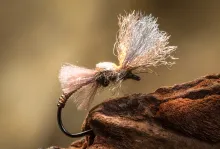Wow. Three hundred and forty four pages of emergers. Leeson and Schollmeyer have done it again.
Updated or edited 9 months ago
Wow. Three hundred and forty four pages of emergers. Leeson and Schollmeyer have done it again.
Unlike their massive Fly Tier's Benchside Reference, the emphasis in this book is on patterns and step-by-step instructions, where the authors tie a specific fly from start to finish. What this book has in common with their magnum opus, however, is the crisp full-color photographs and no-stone-uncovered attitude. While the Benchside Reference covered a very broad subject matter, Tying Emergers tackles a very narrow subject, yet drills down as far as possible and manages to almost equal their earlier famous work in sheer weight.
The book has essentially two majors sections - one section dealing with design and tying techniques, and another section dealing with fly styles and step-by-step instructions.
To give you an idea of how much homework went into this book, consider the fact that there are twenty pages devoted to different types of shucks. If you believe these pages are mostly fluff with lots of full page photographs, you'd be wrong. The photographs are rather small, not at all designed to dominate, but instead are properly used to accentuate the rich text. In other words - you gotta be prepared to sit down and read when you get this book.
The portion of the book dealing with individual flies is grouped according to emerger style - parachute emergers, downwing emergers, loopwing emergers, etc. The flies come from a wide variety of tyers, including such household names as Oliver Edwards, Shane Stalcup, and Rene Harrop. What I found interesting is the number of contributors who are regulars on the various fly tying boards on the internet. It was just a few years ago that print media pretty much snubbed the internet world, but these days more and more tyers are making names for themselves by being active in the internet tying and fishing community.
For these flies, you get a photo of the completed fly, a recipe, some introductory text, and then a step-by-step instructional sequence. I appreciated how the authors would refer to prior sections for different techniques or tying ideas, rather than repeating themselves. Fly tyers of average ability will have no problem following these instructions. I could not see where any shortcuts were taken that would risk the instructional value, nor did I notice the tyers "dumbing down" their instructions to a novice tyer. In other words, the instructions assume you know how to tie in materials and finish off a fly.
On the other hand, I was a bit sorry to see the section on basic tying techniques. This is a common criticism I have for specialized books such as this. Beginners are not going to buy this book to learn how to tie flies, so the authors should do the publisher and reader a favor and omit instructions of the fundamentals. Point the reader to another text (benchside reference, perhaps?) and get on with business. I'm pretty sure the audience for this book already knows how to do a pinch loop, wrap a wet fly hackle, or has a good technique for wrapping herl. I would rather see emerger-specific techniques covered here or in the patterns themselves, and omit the Fly Tying 101 stuff. "Nuff said.
The section on materials was certainly appropriate, however. Starting with a basic discussion of emerger design, the authors go on to discuss how materials affect the implementation of these designs. Specifically, the discussion of hook styles was excellent.
If you have an interest in emergers, save your pennies and get a copy of this book. I can't imagine anyone who would not learn a thing or two during the course of reading cover-to-cover, whether a new tying technique or a new pattern style.
- Log in to post comments







